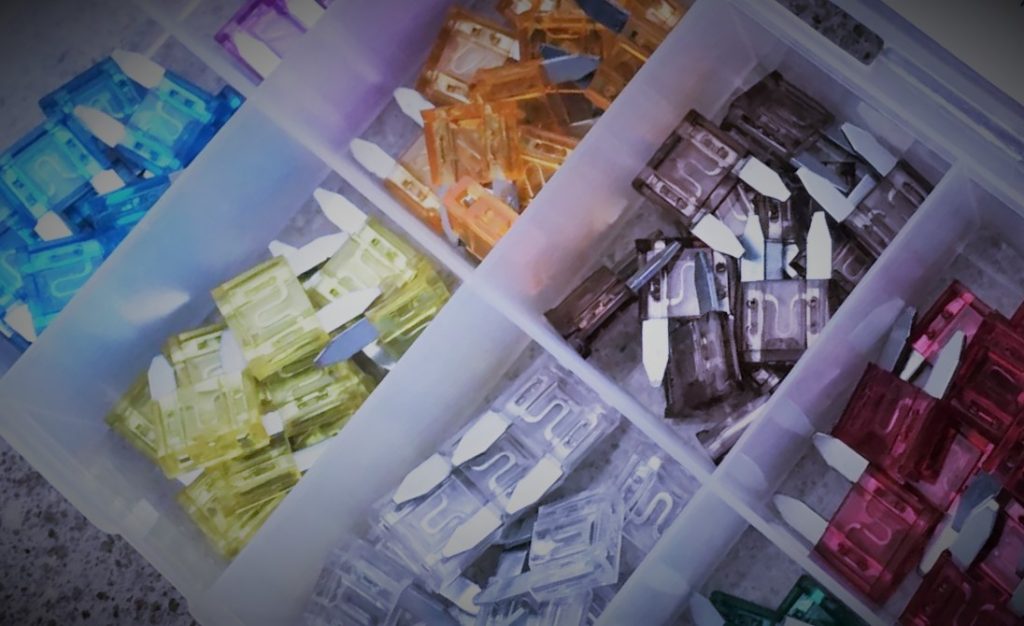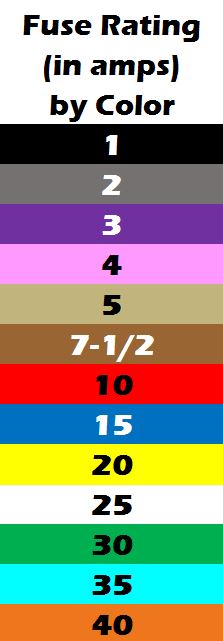Fuses are an essential part of any electrical system.
They are designed to fail automatically in the event of an electrical overload or short—sacrificing themselves to save your wiring harness.
Given the nature of how fuses work, it’s critical that you use the proper amp rating for the circuit. Too low a value and your fuses will blow prematurely, while using too high a value defeats the purpose of the fuse in the first place.

There are several automotive fuse types, but today we’re talking about the blade-style fuses found in most modern cars made after 1980. Keep in mind that there are several different types of blade fuses beyond the standard ATC size too, including Mini (ATM), Maxi (APX), and Low-Profile Micro (ATT) styles.
Regardless of the style of blade fuse, these fuses—used in automotive (and other electrical component) applications—typically follow a standard color-coding scheme that makes it easy to identify their respective electrical current ratings.

At first you might think “Heck, it’s easy to identify these, they’ve got the number written right on ’em. I don’t need to know the color.”
And that’s somewhat correct, though some fuses simply have the number embossed in the plastic and not painted. More importantly, fuse boxes often are located in the dark recesses under a dashboard or in a dirty engine bay where they can be difficult to read.
That’s why being able to identify them by their color is such a big help. We looked to the fuse experts at Bussman to help compile these handy guides.
You can use the virtual table below or CLICK HERE for a handy downloadable chart that has both the colors displayed and the color names spelled out. That way, you can use it regardless of whether you print it with a color printer or not.
Fuse Color Codes, by Amp
| Color | Amp Rating |
|---|---|
| Dark Blue | 0.5 |
| Black | 1 |
| Gray | 2 |
| Violet | 3 |
| Pink | 4 |
| Tan | 5 |
| Brown | 7-1⁄2 |
| Red | 10 |
| Blue | 15 |
| Yellow | 20 |
| Clear | 25 |
| Green | 30 |
| Aqua Blue | 35 |
| Orange | 40 |
| Red* | 50 |
| Blue* | 60 |
| Amber/Tan* | 70 |
| Clear* | 80 |
| Violet* | 100 |
| Purple* | 120 |
| * Some of the colors repeat. This is because all fuse types have limits; for example, MAXI fuses do not go below 20 amps and AGC fuses don’t go above 50 amps. | |

[…] Fusible links—also spelled fuseable and fusable—serve a similar purpose to a fuse. (You can read more about fuses here.) […]
I would like to get a Fuse Selection chart.
Sold industrial automation for 15 years. Represented 180 companies, one was Bussman fuse, great company,great reps too!
Simple to the point article!
Rewiring a 1961 wooden classic boat and could definitely use the black and white guide. Thank you!
Hey Guys, we added a downloadable PDF version of the Fuse Color Code Chart too–so you can save it, print it, and tape it up in the shop.
Very informative chart, thanks for the kmowledge!
I needed a 7.5 amp fuse for my motorcycle, so I looked in a box that had a lot of old fuses in and found some. The problem is they were clear instead of Brown. According to the color chart 7.5 should be brown. Don’t know were these fuses came from and was wondering when did they start color coding fuses?
Thanks, Tom
Hey Tom, we’re not really sure when color-coding began, but its entirely possible they could’ve all been clear at some point. Though we can all see why that’d be frustrating and why they (probably) quickly converted to a color system!
…
But you bring up a point worth mentioning: This color code chart only applies to automotive-style blade fuses. Some earlier fuses (Bosch & Lucas come to mind) use a different color scheme. Though those are becoming quite rare, as you’d typically find ’em in older European vehicles.
[…] There are a few different sizes of automotive fuses nowadays. The most common two are standard and mini blade style, pictured here. Make sure your kit […]
Bravo! Very helpful.☺️
[…] If you can’t find your owner’s manual, don’t worry, fuses are color-coded, so you can still find the amperage rating using the following color chart: […]
Good color chart for fuses and good information included. Job well done.
The yellow 20 fuse where does go to in the fuse box?
What happens if you use a motorcycle fuse in the car?
Hey Rachel, never heard of a motorcycle-specific fuse before. My old bikes typically used an ordinary glass fuse, and the newer ones have modern ATC blade style fuses. Though keep in mind, there are a handful of different blade fuse types nowadays, including the aforementioned ATC, along with the smaller ATO and ATM designs.
…
The big thing to remember is to use the one that’s factory rated for the circuit. IE, if it is spec’d for a 5 amp fuse, don’t substitute a 10 amp, etc.